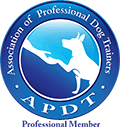OLDT Archive :: It's Not My Fault!
Inadvertently Reinforced Bad Behaviors
Now here's an alarming fact: Every interaction you have with your dog results in his learning something, whether you intentionally meant to train him or not! In a young dog, this is especially significant, since he has less of a history with you and so each interaction has a greater impact.
So what are the most common unintentionally trained bad behaviors?! See if these sound familiar...
The Pushy Pooch
You're walking with your dog when you run into a friend. You stop to chat and your dog sits quietly beside you and waits. After a while, he gets impatient and fidgety, tired of the boring human chatter, and he starts to bark and jump on you, eager to resume the journey. To buy yourself a little more time, you give your pup some treats in an effort to quiet him. Now you've noticed that he starts barking and jumping on you almost immediately when you meet people on the street.
|
So how did he learn that? Unfortunately this one is the most common and the most insidious. The pitfall is that the good behavior is so easily overlooked but the bad behavior is overt and annoying and rather hard to ignore. In the example, when your dog was sitting quietly and patiently, his behavior went unnoticed and unappreciated. When he became impatient and demanding, his behavior was rewarded with hush money.
And how do you fix it? This is another time when you should step on your dog's leash at a distance from him where he can sit or stand comfortably but cannot jump up. |

| |
|
Cue him to sit and start giving him little pieces of treats, first fairly frequently, then increasing the duration between treats. We're working on building his patience. Should your dog bark at you, give him a time-out by turning your back on him (with your foot still on the leash) and ignoring him, only turning to face him when he's quiet.
In these early practices, stop along the street without conversing with anyone. You'll need to devote your full attention to these early exercises. As he gets better, recruit friends to join you, as having other people around changes the exercise for you and for him. You will be somewhat distracted at first and a friend will understand this and not expect you to carry on a complete conversation. Soon enough, you'll both be ready for prime time! A final note: If his demand behavior includes mouthing, nipping at hands or clothes, then consider using a head collar (like a Gentle Leader, a Halti, or a Snoot Loop) which will give you more control of his head and allow you to zip his mouth shut when needed. | ||
The Rude Greeter
Your dog is a social butterfly. He just loves jumping up to give kisses, and, while some people greet him with open arms, others push him away. And the trouble is he's getting more exuberant with each passing day.
So how did he learn that? It's a natural behavior for dogs to sniff faces as part of their greeting ritual, but the problem is that it's not part of our greeting ritual. The behavior is then encouraged by those people who enjoy bouncy dogs and give them lots of love and pets while they're leaping up on them. Strangely enough, though, even those people who don't like a jumping dog often contribute to the problem by pushing them off with their hands. Touch is very reinforcing and so even touch used in an attempt to push away the dog will likely encourage the behavior.
And how do you fix it? For starters, you need to use some management techniques to get the ball rolling in the right direction. With your dog on leash, step on his leash at a distance from him where he can sit or stand comfortably but where he cannot jump up. Recruit a friend to help you with the exercise. Have your friend stand 10 feet or so away with some treats in his hand and have him play with the treats a bit in order to keep your dog focused on the game. Now here's the key: WAIT for your dog to offer a sit. Don't ask for it. I've found that dogs tend to learn better when they do their own problem-solving. When we give them the answer, they seem to need us to keep giving them the answer time and time again. So wait for a sit and, this first time, that wait could take quite a while! As soon as your dog's butt hits the ground, your friend should start to walk slowly toward you. If your dog stands up, your friend should immediately start to back away. When pup sits again, your friend proceeds forward. While your friend may feel like a human yoyo, your dog is being taught impulse control -- that the things he wants in life will only be granted to him for polite behavior. A valuable life lesson!
The Sock Stealer
Your pup seems to have a knack for stealing your most sensitive things -- socks, slippers, underwear, and the like. Even more annoying, it becomes a frustrating game of keep-away with you chasing him in circles and now it's happening daily.
So how did he learn that? The funny thing is that dogs pick up things all the time -- paper, toys, rawhides, socks, everything! The only difference is that we don't mind one bit when the article is one of his own toys. The problems begin when he picks up something of ours and we tend to get emotional about it and will go to great lengths to retrieve it from him. It's this difference in our reaction that actually encourages the behavior. The great game of chase that erupts when he picks up forbidden items is what makes those items so much more enticing to grab.
And how do you fix it? Teach your dog to drop things on cue, all things -- his belongings as well as yours. When he's got hold of something, say "drop it!" and then hold a treat to his nose. When he drops the toy, give him the treat and take the toy. Then offer him the toy back. The ultimate goal is for him to automatically yield the toy upon hearing the command, so make sure it's the command first, then the lure on the nose, and then the treat for the drop. There will be some articles for which you say "drop it" that you will not return to him, like a sock but, after you've done so many repetitions with articles that you immediately return to him, he's going to think "drop it" is a win-win -- he gets a treat for doing it and he gets the toy back. And it's a great way to teach your dog how to share.
A final note: Puppy-proof your house as much as possible so that your dog doesn't have the opportunity to grab the wrong things: put shoes in the closet and dirty socks in the hamper. Then his play behaviors will develop for appropriate targets.
The Party Pooper
You've settled down to watch a little TV, having just returned from your pup's last potty break for the night, when your dog comes darting out from behind the couch and starts running in the crazy circles you recognize as his post-poop victory laps. You know that he knows he's being bad, since otherwise he wouldn't be seeking out hiding places for the dirty deed.
So how did he learn that? What looks to us as guilt for wrong-doing is really just done in an effort to avoid punishment for a behavior he does not understand to be wrong. It's often accompanied by a low body posture and low tail wag, appeasement gestures used in an effort to turn off what your dog construes as your unpredictable anger.
A variation on this theme is the dog who squats on the carpet right in front of you and pees. Such behavior is often attributed to "dominant" behavior but it's really little more than attention-seeking behavior, much like the sock stealing scenario. (See the article Understanding a Dog’s Inner Puppy.)
Either way, the truth is that your dog is not fully house-trained. While he may do his business outside most of the time, it is still not clear to him that "outside's good, inside's bad".
And how do you fix it? Go the extra mile to get your dog fully housetrained; this means being more vigilant with him in the house. Keep things positive, praising and treating for pottying in the right place and quietly cleaning up mistakes in the wrong place. Punishment for breaks in housetraining only causes anxiety and further transgressions.
The Upshot
When troublesome behaviors worsen, turn a critical eye to what might be inadvertently reinforcing them. Investigate management techniques (the leash can be a great tool) that will help inhibit the bad behavior while alternate behaviors are shaped. Finally, envision what you'd rather your dog do than the behavior he's chosen -- for instance, sitting rather than jumping up -- and help him find his way to being a better dog!




